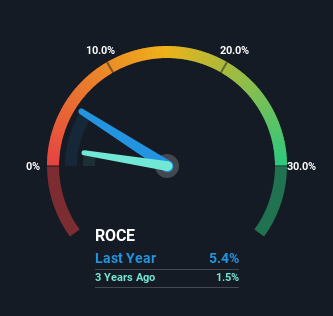Return Trends At VIP Clothing (NSE:VIPCLOTHNG) Aren't Appealing

If you're looking for a multi-bagger, there's a few things to keep an eye out for. Ideally, a business will show two trends; firstly a growing return on capital employed (ROCE) and secondly, an increasing amount of capital employed. Ultimately, this demonstrates that it's a business that is reinvesting profits at increasing rates of return. However, after investigating VIP Clothing (NSE:VIPCLOTHNG), we don't think it's current trends fit the mold of a multi-bagger.
What Is Return On Capital Employed (ROCE)?
For those that aren't sure what ROCE is, it measures the amount of pre-tax profits a company can generate from the capital employed in its business. To calculate this metric for VIP Clothing, this is the formula:
Return on Capital Employed = Earnings Before Interest and Tax (EBIT) ÷ (Total Assets - Current Liabilities)
0.054 = ₹85m ÷ (₹2.8b - ₹1.3b) (Based on the trailing twelve months to June 2022).
So, VIP Clothing has an ROCE of 5.4%. In absolute terms, that's a low return and it also under-performs the Luxury industry average of 13%.
Check out the opportunities and risks within the IN Luxury industry.

Historical performance is a great place to start when researching a stock so above you can see the gauge for VIP Clothing's ROCE against it's prior returns. If you want to delve into the historical earnings, revenue and cash flow of VIP Clothing, check out these free graphs here.
So How Is VIP Clothing's ROCE Trending?
We're a bit concerned with the trends, because the business is applying 27% less capital than it was five years ago and returns on that capital have stayed flat. When a company effectively decreases its assets base, it's not usually a sign to be optimistic on that company. In addition to that, since the ROCE doesn't scream "quality" at 5.4%, it's hard to get excited about these developments.
On a separate but related note, it's important to know that VIP Clothing has a current liabilities to total assets ratio of 45%, which we'd consider pretty high. This effectively means that suppliers (or short-term creditors) are funding a large portion of the business, so just be aware that this can introduce some elements of risk. While it's not necessarily a bad thing, it can be beneficial if this ratio is lower.
What We Can Learn From VIP Clothing's ROCE
Overall, we're not ecstatic to see VIP Clothing reducing the amount of capital it employs in the business. And in the last five years, the stock has given away 28% so the market doesn't look too hopeful on these trends strengthening any time soon. Therefore based on the analysis done in this article, we don't think VIP Clothing has the makings of a multi-bagger.
Since virtually every company faces some risks, it's worth knowing what they are, and we've spotted 3 warning signs for VIP Clothing (of which 2 make us uncomfortable!) that you should know about.
If you want to search for solid companies with great earnings, check out this free list of companies with good balance sheets and impressive returns on equity.
New: Manage All Your Stock Portfolios in One Place
We've created the ultimate portfolio companion for stock investors, and it's free.
• Connect an unlimited number of Portfolios and see your total in one currency
• Be alerted to new Warning Signs or Risks via email or mobile
• Track the Fair Value of your stocks
Have feedback on this article? Concerned about the content? Get in touch with us directly. Alternatively, email editorial-team (at) simplywallst.com.
This article by Simply Wall St is general in nature. We provide commentary based on historical data and analyst forecasts only using an unbiased methodology and our articles are not intended to be financial advice. It does not constitute a recommendation to buy or sell any stock, and does not take account of your objectives, or your financial situation. We aim to bring you long-term focused analysis driven by fundamental data. Note that our analysis may not factor in the latest price-sensitive company announcements or qualitative material. Simply Wall St has no position in any stocks mentioned.
About NSEI:VIPCLOTHNG
VIP Clothing
Engages in the manufacture, marketing, and distribution of garments in India.
Excellent balance sheet low.
Similar Companies
Market Insights
Community Narratives



